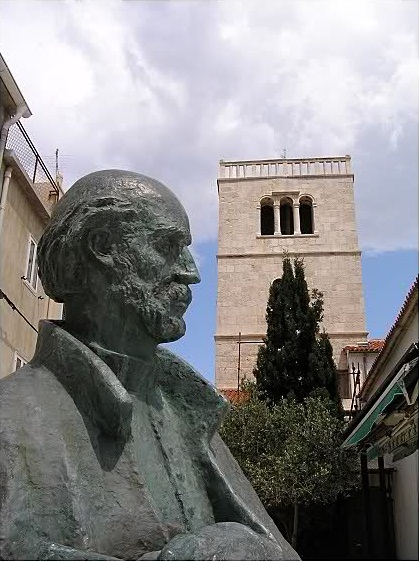<Back to Index>
- Linguist Bartol Kašić, 1575
- Writer Walter Scott, 1771
- Taoiseach of Ireland John Mary "Jack" Lynch, 1917
PAGE SPONSOR

Bartol Kašić (also Bartul Kašić, Bartholomaeus Cassius, Bartolomeo Cassio, sometimes signing as Bogdančić and/or Pažanin; August 15, 1575 - December 28, 1650) was a Croatian linguist. He wrote the first Croatian grammar and translated the Bible and the Roman Rite into Croatian. He is considered the father of Croatian linguistics and one of the greatest men of letters in Croatian history.
Kašić was born on the island of Pag. His father died when he was a small child, so he was raised by his uncle Luka Deodati Bogdančić, a priest from Pag, who taught him to read and write. He attended the municipal school in the town of Pag. After 1590 he studied at the Illyric College in Loreto near Ancona, Italy, managed by the Jesuits. As a gifted and industrious pupil, he was sent to further studies in Rome in 1593, where he joined the Society of Jesus in 1595.
Kašić was made a priest in 1606 and served as a confessor in the St. Peter's Basilica in Rome. He lived in Dubrovnik from 1609 to 1612. In 1612/13, disguised as a merchant, he went on a mission to Bosnia, Serbia and eastern Slavonia (Valpovo, Osijek, Vukovar), which he reported to the pope. From 1614 to 1618 he was the Croatian confessor in Loreto. He went on his second mission in 1618/19. In old age, he described both missions in his incomplete autobiography. His second stay in Dubrovnik lasted from 1620 to 1633. Then he returned to Rome, where he spent the rest of his life.
Already as a student, Kašić started teaching Croatian in the Illyric Academy in Rome, which awakened his interest in the Croatian language. By 1599 he compiled a Croatian - Italian dictionary, which has been preserved as a manuscript in Dubrovnik since
the 18th century. Some experts believe it is one of three dictionaries
made by Kašić and that the other two are archived in Perugia and Oxford. It qualified Kašić for further work in the area of Croatian language. Since the Jesuits took care of the Christians in the Ottoman Empire and tried to teach in the local language, they needed an adequate textbook for working among the Croats. Kašić provided such a textbook: he published Institutionum linguae illyricae libri duo (Latin; "The Structure of the Croatian Language in Two Books") in Rome in 1604. It was the first Croatian grammar. In
almost 200 pages and two parts ("books"), he provided the basic
information on the Croatian language and explained the Croatian morphology in great detail. The language is basically Shtokavian with many Chakavian elements,
mixing older and newer forms. For unknown reasons, the grammar was not
accompanied by a dictionary, as was the practice with Jesuit
dictionaries and grammars of Croatian. After 1613 Kašić published several works of religious and instructive content and purpose (the lives of the saints Ignatius of Loyola and Francis Xavier, the lives of Jesus and Mary), a hagiographic collection Perivoj od djevstva (Virginal Garden; 1625 and 1628), two catechisms etc. In the late 1627 he completed the spiritual tragedy St Venefrida, subtitled triomfo od čistoće (a triumph of purity), which remained in manuscript until 1938. In 1622, Kašić started translating the New Testament into Croatian – more precisely, the Shtokavian dialect of Dubrovnik. In 1625, he was charged with translating the entire Bible.
He submitted the entire translation in Rome in 1633 to obtain the
approval for printing, but he encountered difficulties because some
Croatians were against translations in the vernacular. The translation was eventually forbidden (non est expediens ut imprimatur). Considering the fact that the translations of the Bible to local languages had a crucial role in the creation of the standard languages of
many peoples, the ban on Kašić's translation greatly hindered the
development of the official Croatian language. The preserved manuscripts
were used to publish the translation, with detailed expert notes, in
2000. The great linguistic variety and invention of his translation can be seen from the comparison with the King James Version of the Bible. The King James Version, which has had a profound impact on English,
was published in 1611, two decades before Kašić's translation. It has
12,143 different words. Kašić's Croatian translation, even incomplete
(some parts of the Old Testament are missing), has around 20,000 different words – more than the English version and even more than the original Bible! Ritual rimski (Roman Rite; 1640), covering more than 400 pages, was the most famous Kašić's work, which was used by all Croatian dioceses and archdioceses except for the one in Zagreb, which also accepted it in the 19th century. It was the official liturgical book until
1929. It was the first translation of a Roman rite book into a living
language and it strongly influenced the development of the Croatian
language. In fact, Ritual rimski possibly played a bigger role in the language standardization than
any Bible translation could, despite its stylistic richness and
cultural importance, since the Bible was a crucial factor in this
respect only among Protestant peoples, but not among Catholic ones, as shown by the examples of French and Polish translations. The language used in Ritual rimski is called by Kašić naški ("our language") or bosanski ("Bosnian"). Although he was born in a Chakavian region, he decided to adopt a "common language" (lingua communis), a version of Shtokavian Ikavian, spoken by the majority of Croats. He used the terms dubrovački (from Dubrovnik) for the Ijekavian version used in his Bible, and dalmatinski (Dalmatian) for the Chakavian version.